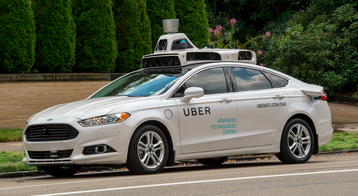Dean Nelson has joined transportation company Uber as head of Uber Compute, as the company continues to expand its data storage and processing capabilities.
Nelson previously worked at companies including Sun Microsystems, Allegro Networks, and eBay. In March, he left his position as the man leading eBay’s data center strategy to establish a data center industry group called Infrastructure Masons.
Uber alles
“My pivotal moment is today. I’m starting the most exciting job of my career as the Head of Uber Compute,” Nelson said in a LinkedIn post.
“I was intrigued when I read the job description, but after spending time with the leaders and hearing their strategy and ambitions, I was blown away!”
Uber’s data center ambitions have been muted so far, but that may be set to change. In 2015, the company bought a small modular data center from Microsoft, but beyond that it has relied on large wholesale turn-key leases, ranging from to 4 to 6 megawatts, at Digital Realty and CoreSite facilities to support its data needs.
Those needs are growing rapidly as Uber continues to expand. Its core service - human-driven personal transportation - passed two billion rides across more than 60 countries this July, some funded by public transit agencies. That same month, the company announced a $500 million global mapping project as it attempts to reduce its reliance on Google Maps.
This summer, Uber also rolled out its food delivery service UberEats to several new cities and countries, aggressively marketing its product and gaining significant market share from incumbent rivals such as Deliveroo. On-demand delivery service UberRush equally saw expansion, cutting into the markets of companies like Instacart.
But while tracking its hundreds of thousands of drivers, optimizing routes, and pegging journey price to demand at a particular moment certainly requires large storage and processing resources, the next stage of Uber’s master plan is certain to need much more.
With high driver turnover rates (30 percent in 2013), Uber has tried to increase its number of employees through initiatives including subprime auto leases, but its ultimate aim is to do away with human drivers entirely.
In February 2015, Uber announced a ’strategic partnership’ with Carnegie Mellon University’s National Robotics Engineering Center to work on self-driving car technology.
Soon after, Uber simply hired around 40 NREC employees, including its director and several key program directors, and housed them in an office near the original NREC site.
This August, Uber shelled out $680 million for Otto, a self-driving truck startup led by the former head of Google’s self-driving car project, Anthony Levandowski. Otto will continue as Uber’s subsidiary focused on the trucking business, while Levandowski will oversee Uber’s entire self-driving business.
In the same month, the company revealed a $300 million partnership with Volvo, aiming to put 100 SUVs with self-driving tech on the roads in Pittsburgh. The cars have been deployed but are still monitored and controlled by a human driver who ensures that the cars do not crash.
“Let that sink in for a second. While the world talks about the future of self-driving vehicles, Uber launches it as part of their core business. No speculation, actual rides!” Nelson said.
He continued: “Uber city expansion is a challenge in and of itself, but imagine the amount of data being generated from these self driving cars. That data needs to be collected, ingested, analyzed and acted upon rapidly. This is Artificial Intelligence and Deep Learning on a grand scale.”
Nelson will lead the team trying to overcome this challenge, and is looking to hire more personnel. A respected figure in the industry, Nelson was previously chair of the Green Grid’s end-user advisory council, chairman and founder of Data Center Pulse, and chair of efficiency of the TBM Council. He remains head of Infrastructure Masons.
While at eBay, Nelson built a data center in Utah, powered entirely by fuel cells, and successfully split the eBay and PayPal commerce engines.


